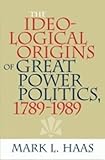The Ideological Origins of Great Power Politics, 1789–1989 / Mark L. Haas.
Material type: TextSeries: Cornell Studies in Security AffairsPublisher: Ithaca, NY : Cornell University Press, [2018]Copyright date: ©2007Description: 1 online resource (248 p.) : 3 tables, 3 charts/graphsContent type:
TextSeries: Cornell Studies in Security AffairsPublisher: Ithaca, NY : Cornell University Press, [2018]Copyright date: ©2007Description: 1 online resource (248 p.) : 3 tables, 3 charts/graphsContent type: - 9781501732461
- 327.1/09 23
- JZ1253 .H33 2007eb
- online - DeGruyter
| Item type | Current library | Call number | URL | Status | Notes | Barcode | |
|---|---|---|---|---|---|---|---|
 eBook
eBook
|
Biblioteca "Angelicum" Pont. Univ. S.Tommaso d'Aquino Nuvola online | online - DeGruyter (Browse shelf(Opens below)) | Online access | Not for loan (Accesso limitato) | Accesso per gli utenti autorizzati / Access for authorized users | (dgr)9781501732461 |
Frontmatter -- Contents -- Acknowledgments -- Introduction -- 1. Ideological Similarities and Differences and Leaders' ix 1 Perceptions of Threat -- 2. The Three Wars of the French Revolution -- 3. The Concert of Europe, 1815-48 -- 4. The 1930s and the Origins of the Second World War -- 5. The Rise and Fall of the Sino-Soviet Alliance, 1949-60 -- [6] The 1980s and the End of the Cold War -- Conclusion -- Index -- About the Author
restricted access online access with authorization star
http://purl.org/coar/access_right/c_16ec
How do leaders perceive threat levels in world politics, and what effects do those perceptions have on policy choices? Mark L. Haas focuses on how ideology shapes perception. He does not delineate the content of particular ideologies, but rather the degree of difference among them. Degree of ideological difference is, he believes, the crucial factor as leaders decide which nations threaten and which bolster their state's security and their own domestic power. These threat perceptions will in turn impel leaders to make particular foreign-policy choices. Haas examines great-power relations in five periods: the 1790s in Europe, the Concert of Europe (1815–1848), the 1930s in Europe, Sino-Soviet relations from 1949 to 1960, and the end of the Cold War. In each case he finds a clear relationship between the degree of ideological differences that divided state leaders and those leaders' perceptions of threat level (and so of appropriate foreign-policy choices). These relationships held in most cases, regardless of the nature of the ideologies in question, the offense-defense balance, and changes in the international distribution of power.
Mode of access: Internet via World Wide Web.
In English.
Description based on online resource; title from PDF title page (publisher's Web site, viewed 26. Apr 2024)


